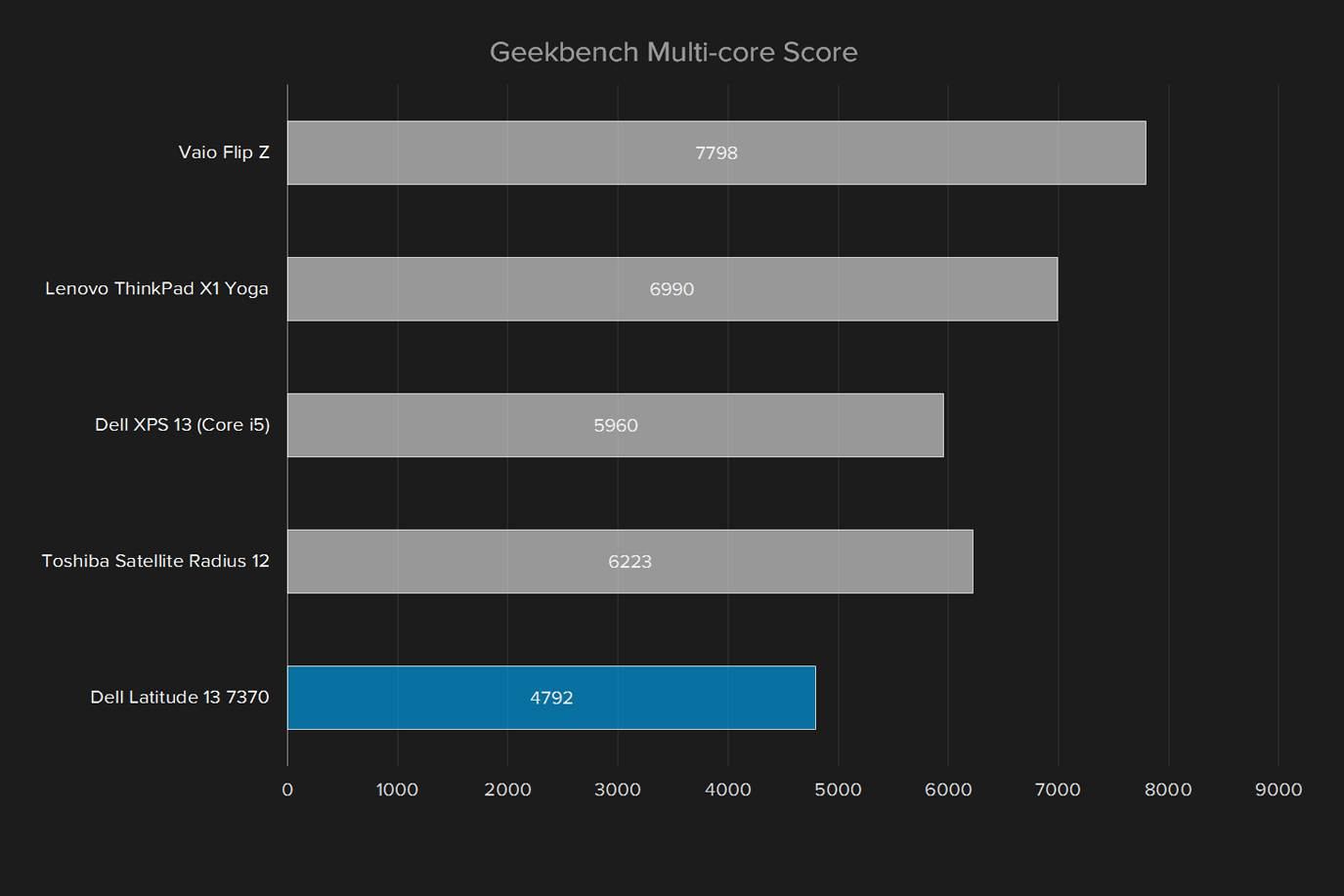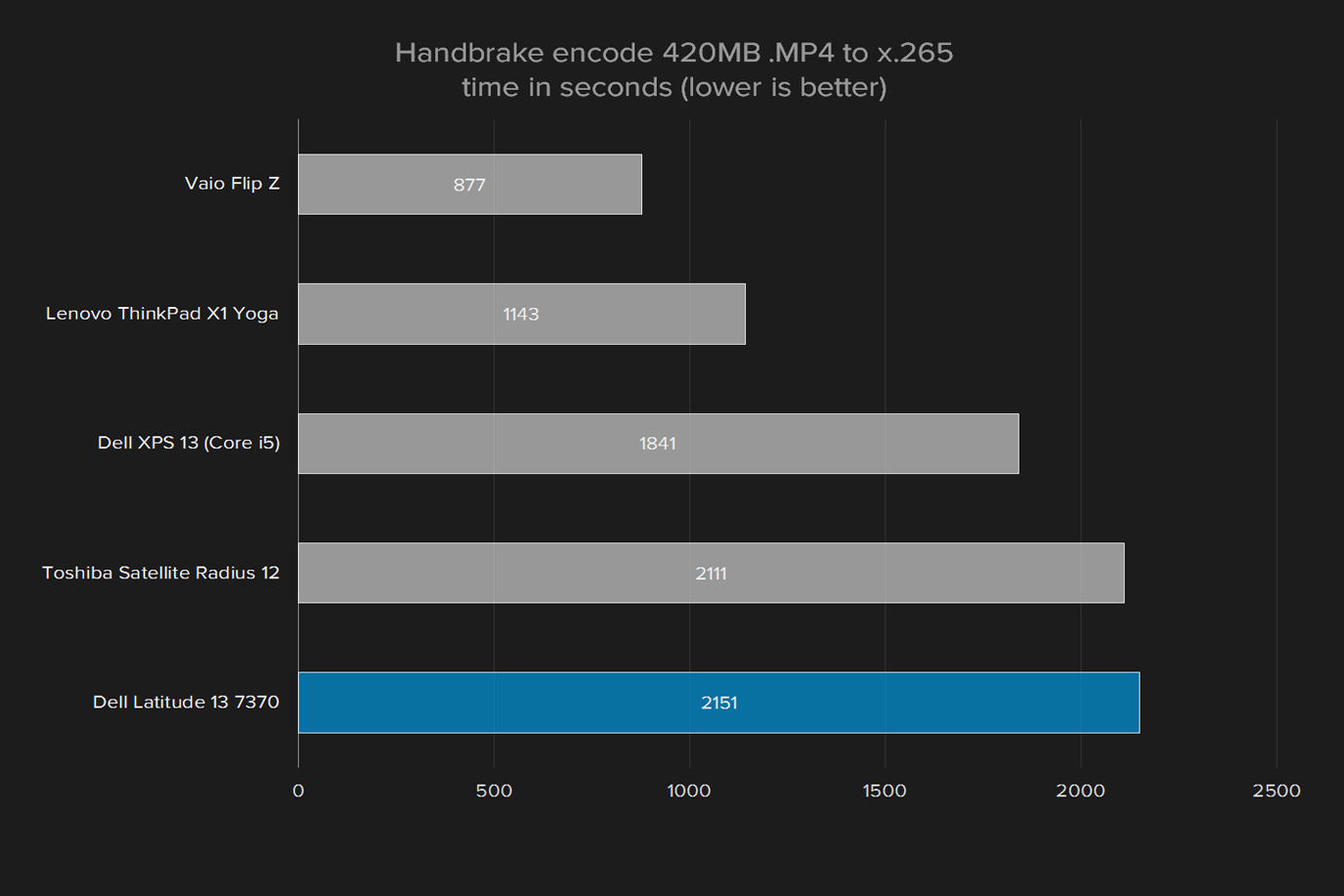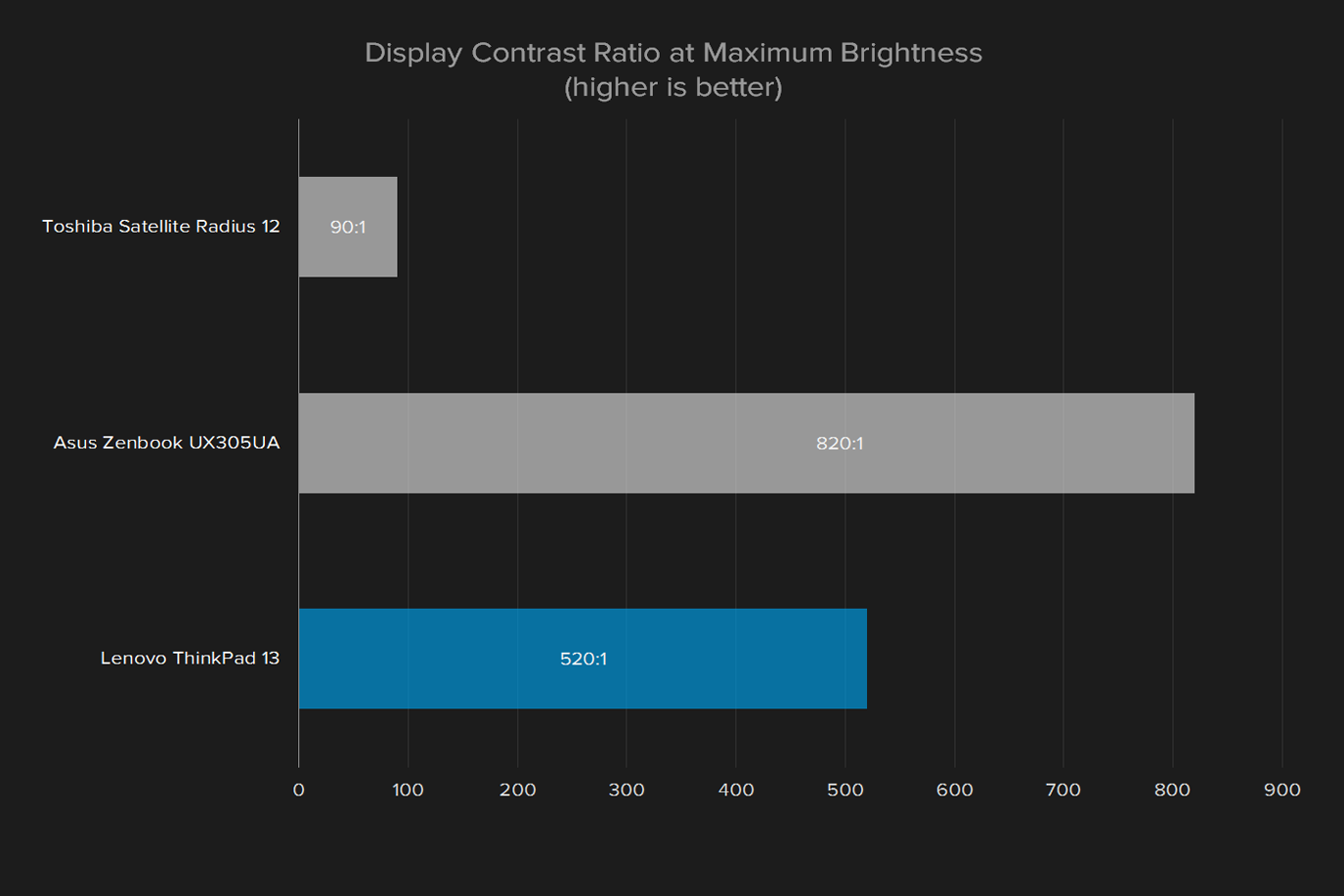“Feather-light but overpriced, the Latitude 13 7370 doesn’t make fiscal sense.”
- Light, carbon fiber body
- Great wireless connectivity, including LTE data
- Standard 3-year warranty
- Dull exterior, especially without carbon lid
- Only one USB port standard
- Weak processor and graphics performance
- Extremely expensive
Dell’s 2014 re-design of the XPS 13 proved the company has found a new design language that works, and it’s done all it can to expand that into other products. New Dell laptops are often thinner and more compact than rivals, yet still boast the latest hardware.
The focus on portable design has bled over to Dell’s enterprise systems, such as the Latitude 13. These systems have never been the most attractive — and the new Latitudes don’t change that — but they do prioritize portability. Dell’s Latitude 13 7370, a high-end ultrabook for business travelers, exemplifies that focus. It’s barely over a half-inch thick, weighs just under 2.5 pounds, and has the same thin-bezel InfinityEdge display found on the XPS 13.
Shaving weight necessitates a dramatically different hardware configuration. The Latitude 13 7370 has a Core m5 processor, rather than Core i5. It also has a smaller battery than the XPS 13 (and most other 13-inch notebooks), and ditches the cooling fan. Oh, and there’s one other change. The price has skyrocketed. Base models are $1,300 with a Core m3 processor, and our review unit rang up to almost $2,100.
These changes make for a system that’s more of a business-focused take on the MacBook than a standard 13-inch ultrabook. Does Dell’s pursuit of ultimate portability make sense, or is the Latitude under-powered for its category?
Full carbon fiber
You’d be forgiven for thinking the Latitude 13 7370 is just a slight tweak of the XPS 13. The two share many design traits, such as a broad hinge, thin-bezel display, and the location of some ports. At a glance, the only obvious change is the switch from metal display lid to carbon fiber (an optional upgrade that adds $70 to the price).
Yet they’re not as similar as they seem. The Latitude 13 7370 is more similar to the Asus UX305CA, or Apple’s MacBook. It lacks a cooling fan, so there’s no intake or exhaust. That also thins the system and keeps it level, so the chassis is about as thick at the front as at the back. The touchpad and keyboard are entirely different, too.
Together, the alterations change the character of the system. It feels wonderfully light (because it is) and enjoys the granite-like stiffness shared by all fanless ultrabooks. This PC feels ready to handle the rough-and-tumble lifestyle that business notebooks often face.
But they don’t make the Latitude 13 7370 attractive. While some may enjoy the carbon-fiber weave look of the optional display lid, the overall look is black, black, and more black. We’re talking ThinkPad levels of dull. The Latitude doesn’t offend any business prospects, but it also means it doesn’t look as expensive as it is.
Forward-thinking connectivity
You’ll find not one but two Thunderbolt 3 ports on this ultrabook, one of which is used to charge the system. There’s also a USB 3.0 port, micro-HDMI output, a combo headphone/microphone jack, and an SD card reader. This is a forward-thinking port selection that provides a lot of flexibility. However, users will probably need adapters to get the most from it. The single USB port is the most serious limitation.
Wireless connectivity is another matter. Wi-Fi is provided by a dual-band 802.11ac adapter, and includes Bluetooth 4.1. There’s also optional LTE mobile data support and an optional SmartCard reader. The use of a dual-band Wi-Fi adapter, alongside optional LTE, means the Latitude 13 7370 can maintain a stable internet connection where other laptops would be knocked offline.
Look! The touchpad has buttons!
The Latitude 13 7370’s keyboard is conventional in every way possible. Even the font is mundane. But sticking to the basics is usually good for keyboards, and that’s the case here. Key travel is good despite the laptop’s thin profile. Individual keycaps are broad, yet there’s also plenty of space between each key. We do think the Asus UX305CA’s keyboard feels tighter, but the difference is slim.
On the touchpad you’ll find something rare; two separate, tactile mouse buttons.
A keyboard backlight is standard. There are just two brightness settings, however, and light leak is evident, especially on the higher of the two settings. The backlight does its job, but it doesn’t look elegant, and isn’t versatile.
On the touchpad you’ll find something rare; two separate, tactile mouse buttons which are not part of the touchpad surface. As usual, this is a trade-off. The buttons are responsive and easy to use, but they reduce the touchpad’s vertical space to just a hair more than two inches, which is quite small. Dell has tuned the default sensitivity so that a full swipe still moves the cursor across the screen – but users who prefer a large touch surface will find the Latitude 7370 restrictive.
High display resolution, with a few faults
The Latitude shares a pair of screen options with the XPS 13: a 1080p non-touch display and a 3,200 x 1,800 pixel touchscreen. Our model came with the latter. But while the resolution was the same as the Dell XPS 13 models we’ve reviewed, the screen was coated with a different treatment that doesn’t show quite as much glare. It’s more reflective than a true non-gloss panel, but still improves visibility in bright environments.
Another small change can be found in the display hinge, which is less restrictive than most ultrabooks. It bends back a full 180 degrees, which can help with finding an angle that reduces glare, or when using the system in a restricted workspace.
Our display quality measurements showed the Latitude’s display is indeed the same in the XPS 13. It hit a contrast ratio of 670:1, and displayed a color gamut spanning 98 percent of sRGB. Both results are almost identical to the XPS, and strong among ultrabooks in general – though not class-leading. A number of competitors, including the Vaio Z Flip and Toshiba Satellite Radius 12, provide better contrast and a similar gamut.
A more detailed look at the display revealed a major strength: color accuracy. We recorded an average color difference of 1.6. Anything below one is near perfection, and most laptops score above two, so this is a solid result.
But the screen also suffers a major weakness: gamma. The ideal curve is a reading of 2.2, but the Latitude produced a reading of 1.9. That indicates an image that is over-bright, and ours showed mediocre grayscale reproduction across the spectrum.
The numbers add up to a display that looks good, but never great. Good contrast and deep blacks make for attractive reproduction of dark scenes in movies and games, but the off-target gamma can result in visual weirdness, like missing detail in those same dark scenes. We also noted that while color was accurate, it never looked vibrant. This was obvious in the trailer for Star Trek: Beyond, where the bright, single-tone uniforms of Starfleet officers looked unremarkable.
Not ready to rock
A pair of forward-facing speakers provide this ultrabook’s audio grunt. They’re clear in the mid-range, but bass can easily overwhelm them. We noticed this in the trailer for Rogue One, where the soundtrack’s most ominous notes distorted into garbled static.
The location of the speakers on the underside of the front lip makes them easy to obstruct, and that can further compromise sound quality. You’ll want to bring headphones while traveling with this notebook.
Core M reaches its limit
Dell has opted to use Intel’s Core M in the Latitude 13 7370, rather than a “standard” Intel Core. The base model has a Core m3-6Y30, and our upgraded review unit came with the m5-6Y57. The review model paired that with 8GB of DDR4 1,600MHz memory.
Core M is built to sip power, and it does just that – at the price of reduced performance.
Choosing Core M creates a problem for the Latitude. Our benchmarks found it the slowest of all the high-end ultrabooks and 2-in-1s we’ve recently reviewed. Geekbench’s multi-core test reported a score of 4,792, which was way behind the Lenovo ThinkPad X1 Yoga’s score of 6,990 and the Vaio Flip Z’s score of 7,798. In Handbrake, the Vaio needed less than half the time to encode the same 4K trailer.
There’s no positive way to spin this. The Latitude 13 7370 is slower – much slower – than its competition in computing performance. That’d be okay if this were an affordable ultrabook like the Asus Zenbook UX305CA, but this Dell is priced to compete with the top tier of portable notebooks. And it can’t keep up.
Samsung’s fast hard drives win again
Our review unit came with Samsung’s PM951 NVMe solid state hard drive. We’ve seen it before – in Dell’s XPS 13, among others – and it’s always proven a top performer with a notable limitation.
Samsung’s PM951 excels in read performance, hitting almost 1,200 megabytes per second. That blows away the ThinkPad X1 Yoga and the Toshiba Satellite Radius, both of which we tested with a solid state hard drive connected over SATA.
However, the PM951 suffers limited write performance. That means sending data to the laptop from another source can prove much slower than loading data that’s already written. Users who often move large files will run into that limitation more frequently.
Still, the Latitude 13 7370’s overall hard drive performance is strong, outpacing most competitors. Only the Vaio Flip Z is quicker. It has the Samsung SM951 – similar to the PM951, but with better flash memory. It exceeds the Latitude’s already quick read speeds without giving up write performance.
GPU performance
The Core m5-6Y57 processor comes with Intel HD Graphics 515, a barebones version of Intel’s integrated graphics. It’s designed to provide the basics, but not much more. And that means nothing good for gaming.
In 3DMark’s Sky Diver test, a synthetic benchmark, the Latitude 13 7370 produces a score that’s about 40 percent lower than competitors with Core i5 and i7 mobile chips. And then there’s the Vaio Flip Z. It once again trounces the Dell, producing a score that’s three times higher. That’s a huge gap. The Vaio can run most modern games at 1080p and low to medium detail; while the Latitude struggles to run, well, anything.
To see how real-world games perform we loaded Counter-Strike: GO. At 1080p and low detail settings the Latitude produced only 42 frames per second, on average, with a minimum of 24 FPS. Cranking detail up to high made the game unplayable, as the average dropped to 14 FPS.
Heroes of the Storm was more than the Latitude could handle. The game averaged 16 FPS even at its lowest settings, making it unplayable given the game’s need for quick reflexes and accurate mouse movement.
Put simply, you shouldn’t buy the Latitude 13 7370 if gaming matters. Intel’s HD 515 is outmatched even in games not thought to be demanding.
Light, but not long-lasting
Dell’s decision to drop back from a Core processor to a Core M seems a play for additional battery life, but a quick look at the specification sheet reveals a problem. The Latitude 13 7370 has a small 34 watt-hour battery, with no optional upgrade. That’s over 20 watt-hours smaller than Dell’s XPS 13, and smaller than any of the Latitude’s competition.

The smaller battery limits the benefit of the Core M chip. While endurance exceeds the Vaio Flip Z and Toshiba Satellite Radius 12, it comes up short of the Lenovo ThinkPad X1 Yoga. Overall, the battery is just mediocre. It’ll probably last a workday of light use, but that’s not guaranteed.
At least the system is easy to pack. Only a few alternatives, including Apple’s MacBook and LG’s gram 14, can claim to be lighter. The Latitude also has a small, lightweight charger, and it can be powered by any USB Type-C input with sufficient juice.
Noise and cooling
As mentioned, the Latitude 13 7370 doesn’t have a cooling fan. That means it’s almost silent. Whatever noise it might make would be the result of electronic whine – and we didn’t notice that in our testing.
The smaller battery limits the efficiency of the Core M chip.
Heat is the price of silence. At idle we measured a maximum external temperature of 97.6 degrees Fahrenheit along the keyboard function row. That’s the highest idle temperature we’ve seen from a laptop so far in 2016.
Load temperatures were just as toasty. We recorded a maximum of 125.5 degrees, five degrees higher than the fanless Asus Zenbook UX305CA, 10 degrees warmer than the ThinkPad X1 Yoga, and 30 degrees warmer than the Dell XPS 13 with Core i5 processor.
Warranty
Unlike most laptops we review, the Latitude 13 7370 comes with a three-year hardware warranty that includes onsite, in-home service. This is much better coverage than is typically available. Most companies charge a couple hundred dollars for the same.
Conclusion
The concept of a “business” PC is vague. In theory, such systems go beyond the norms of a typical consumer laptop. In truth, the line between home and work is vague – and the Latitude 13 7370 is proof of that.
Though not identical to the XPS 13, this Latitude takes inspiration from it. Its similarities in size and weight are too small to matter to even the most discerning user. Some will find the differences in connectivity in keyboard, touchpad, and connectivity more relevant, but even here we think most users will find one to about as good as the other.
Taken on its own, the Latitude 13 7370 is an impressive system. It makes extensive use of carbon fiber, is among the lightest laptops ever built, and is just a couple tenths of an inch thicker than Apple’s MacBook despite the Dell’s better connectivity and superior keyboard. There are reasons to admire this Latitude.
All of which are overshadowed by price. Base models, with Core m3 and 1080p display, sell for as much as a Dell XPS 13 with Core i5 processor and 3,200 x 1,800 pixel touchscreen. Our tricked-out review unit was $2,078, and it’s far from the most expensive model. You can spend almost three grand on the Latitude 13 7370 without getting into niche options, like the LTE modem. The Latitude is also slower than its competitors. Why, then, would anyone pay a premium for it? What makes it better for business than an XPS 13, Lenovo ThinkPad X1 Carbon, or even Asus Zenbook UX305UA?
We have a hard time finding an answer to that question. The Latitude 13 7370 is a slick device, the result of cutting-edge engineering — but its price overshadows its technical excellence.

















